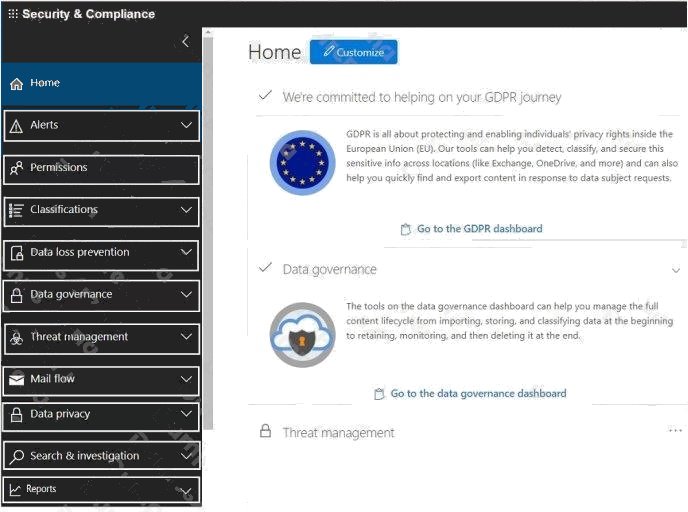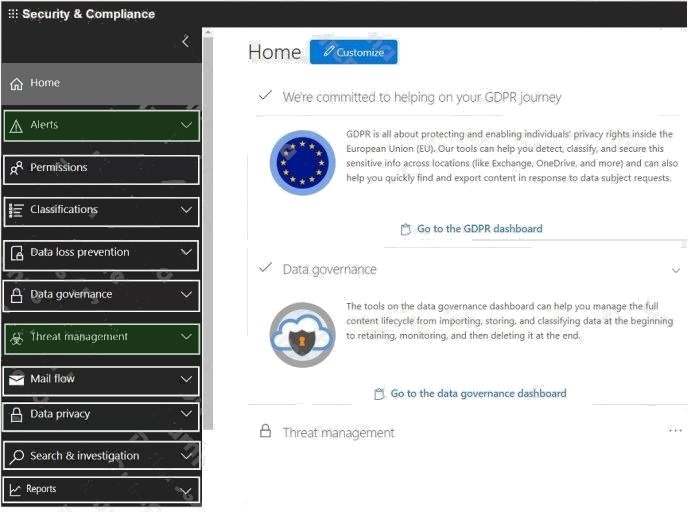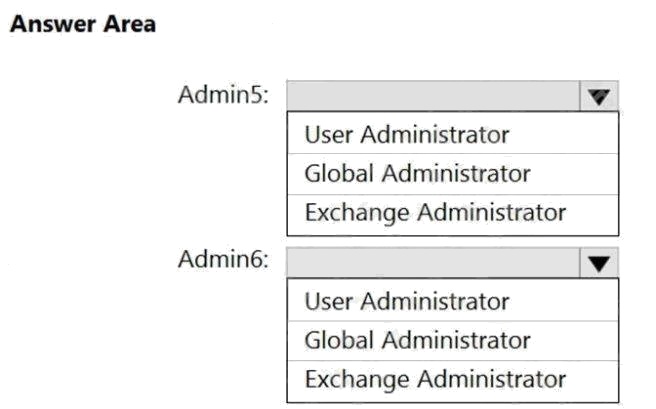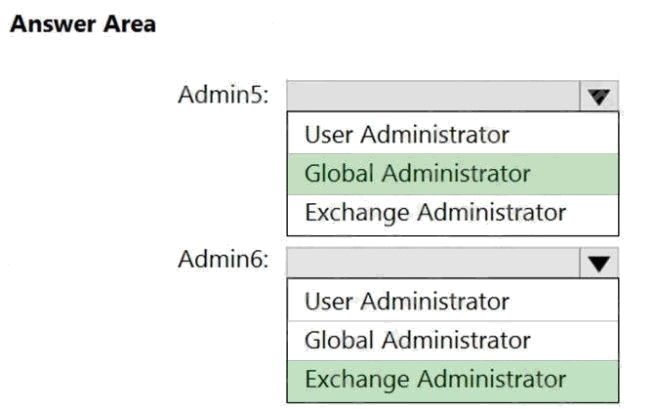microsoft ms-203 practice test
Microsoft 365 Messaging
Note: Test Case questions are at the end of the exam
Last exam update: Apr 17 ,2025
Question 1 Topic 9, Mixed Questions
Note: This question is part of a series of questions that present the same scenario. Each question in the series contains a
unique solution that might meet the stated goals. Some question sets might have more than one correct solution, while
others might not have a correct solution.
After you answer a question in this section, you will NOT be able to return to it. As a result, these questions will not appear in
the review screen.
You have a Microsoft 365 E5 subscription.
You need to ensure that a user named User1 can review audit reports from the Microsoft 365 security center. User1 must be
prevented from tracing messages from the Security admin center.
Solution: You assign the Reports reader role to User1.
Does this meet the goal?
- A. Yes
- B. No
Answer:
B
Question 2 Topic 9, Mixed Questions
You have a Microsoft Exchange Server 2019 organization.
You need to ensure that a user named User1 can prevent mailbox content from being deleted if the content contains the
words Fabrikam and Confidential.
What should you do?
- A. Assign the Mailbox Search and Legal Hold management roles to User1.
- B. Assign the Mailbox Search and Mailbox Import Export management roles to User1.
- C. Add User1 to the Records Management management role group.
- D. Add User1 to the Organization Management management role group.
Answer:
A
Explanation:
Reference:
https://docs.microsoft.com/en-us/exchange/policy-and-compliance/holds/holds?view=exchserver-2019
Question 3 Topic 9, Mixed Questions
Note: This question is part of a series of questions that present the same scenario. Each question in the series contains a
unique solution that might meet the stated goals. Some question sets might have more than one correct solution, while
others might not have a correct solution.
After you answer a question in this section, you will NOT be able to return to it. As a result, these questions will not appear in
the review screen.
You have a Microsoft Exchange Online tenant that contains 1,000 mailboxes.
All the users in the sales department at your company are in a group named Sales.
The company is implementing a new policy to restrict the use of email attachments for the users in the Sales group.
You need to prevent all email messages that contain attachments from being delivered to the users in the Sales group.
Solution: You configure a mailbox quota.
Does this meet the goal?
- A. Yes
- B. No
Answer:
B
Explanation:
Create a mail flow rule.
Reference:
https://docs.microsoft.com/en-us/exchange/security-and-compliance/mail-flow-rules/common-attachment-blocking-scenarios
Question 4 Topic 9, Mixed Questions
Note: This question is part of a series of questions that present the same scenario. Each question in the series contains a
unique solution that might meet the stated goals. Some question sets might have more than one correct solution, while
others might not have a correct solution.
After you answer a question in this section, you will NOT be able to return to it. As a result, these questions will not appear in
the review screen.
You have a Microsoft Exchange Online tenant that contains 1,000 mailboxes.
All the users in the sales department at your company are in a group named Sales.
The company is implementing a new policy to restrict the use of email attachments for the users in the Sales group.
You need to prevent all email messages that contain attachments from being delivered to the users in the Sales group.
Solution: You modify the permissions granted to the Sales group.
Does this meet the goal?
- A. Yes
- B. No
Answer:
B
Explanation:
Create a mail flow rule.
Reference:
https://docs.microsoft.com/en-us/exchange/security-and-compliance/mail-flow-rules/common-attachment-blocking-scenarios
Question 5 Topic 9, Mixed Questions
You have a Microsoft Exchange Server 2019 organization.
You need to provide a user named User1 with the ability to create and manage transport rules.
To which management role group should you add User1?
- A. Server Management
- B. Compliance Management
- C. Records Management
- D. Hygiene Management
Answer:
C
Explanation:
Reference: https://docs.microsoft.com/en-us/exchange/records-management-exchange-2013-help
Question 6 Topic 9, Mixed Questions
You have a Microsoft Exchange Server 2019 organization. You create a retention policy.
You need to ensure that all email older than one year is moved to an archive mailbox.
What should you use?
- A. a personal tag
- B. a data loss prevention (DLP) policy
- C. a default policy tag
- D. a retention policy tag
Answer:
C
Explanation:
Reference:
https://docs.microsoft.com/en-us/exchange/policy-and-compliance/mrm/retention-tags-and-retention-
policies?view=exchserver-2019
Question 7 Topic 9, Mixed Questions
Your company has a Microsoft Exchange Server 2019 organization.
You are auditing the Litigation Hold on the mailboxes of the companys research and development department.
You discover that the mailbox of a user named User1 has a Litigation Hold enabled.
You need to discover who placed the Litigation Hold on the mailbox of User1, and when the Litigation Hold was enabled.
Which two actions should you perform? Each correct answer presents part of the solution.
NOTE: Each correct selection is worth one point.
- A. From the Exchange admin center, run a per-mailbox Litigation Hold report.
- B. From PowerShell, run the Get-Mailbox cmdlet.
- C. From PowerShell, run the Get-MailboxStatistics cmdlet.
- D. From the Exchange admin center, run an In-place eDiscovery and Hold report.
Answer:
A C
Question 8 Topic 9, Mixed Questions
You have a Microsoft 365 E5 subscription.
A user attempts to send an email message to an external recipient and receives the following error message: Your message
couldnt be delivered because you werent recognized as a valid sender. The most common reason for this is that your email
address is suspected of sending spam and its no longer allowed to send messages outside of your organization. Contact
your email admin for assistance. Remove Server returned 550 5.1.8 Access denied, bad outbound sender.
You need to ensure that the user can send email to external recipients.
What should you use?
- A. Threat management in the Security & Compliance admin center.
- B. Data loss prevention in the Security & Compliance admin center.
- C. compliance management in the Exchange admin center
- D. action center in the Exchange admin center
Answer:
D
Explanation:
Reference: http://www.noelpulis.com/fix-550-5-1-8-access-denied-bad-outbound-sender/
Question 9 Topic 9, Mixed Questions
You have a Microsoft 365 subscription.
A safe attachments policy that uses Dynamic Delivery is applied to all recipients who match your SMTP domains.
You need to prevent attachments from being scanned when internal users send email to one another.
What should you do?
- A. From the Exchange admin center, create a transport rule.
- B. From the Exchange admin center, modify the malware filter.
- C. From the Security & Compliance admin center, modify the safe attachments policy.
- D. From the Security & Compliance admin center, modify the Service assurance settings.
Answer:
A
Explanation:
Create a transport rule (or mail flow rule as they are called nowadays) to configure the message header: X-MS-Exchange-
Organization-SkipSafeAttachmentProcessing.
Reference:
https://docs.microsoft.com/en-gb/archive/blogs/office365labs/eo-atp-considerations-reports-demonstrations
Question 10 Topic 9, Mixed Questions
DRAG DROP
You have a Microsoft Exchange Server 2019 organization.
You need to identify which accounts in Active Directory are assigned permissions to dismount mailbox databases.
How should you complete the command? To answer, drag the appropriate value to the correct targets. Each value may be
used once, more than once, or not at all. You may need to drag the split bar between panes or scroll to view content.
NOTE: Each correct selection is worth one point.
Select and Place:
Answer:

Explanation:
Reference:
https://docs.microsoft.com/en-us/powershell/exchange/find-exchange-cmdlet-permissions?view=exchange-ps
Question 11 Topic 9, Mixed Questions
You have an Exchange Online tenant.
You need to ensure that the users in your companys finance department can select email messages that will be deleted
automatically one year later. The solution must apply only to the finance department users.
Which two actions should you perform? Each correct answer presents part of the solution.
NOTE: Each correct selection is worth one point.
- A. Publish a label to the finance department.
- B. Create a data loss prevention (DLP) policy that uses the sensitive information type.
- C. For each mailbox in the finance department, configure the retention policy settings.
- D. Create a label that has a retention setting of one year.
- E. For each mailbox in the finance department, configure Message Delivery Restrictions.
Answer:
A D
Explanation:
Create a retention label and publish it to the finance department users.
Reference:
https://docs.microsoft.com/en-us/microsoft-365/compliance/retention?view=o365-worldwide
Question 12 Topic 9, Mixed Questions
HOTSPOT
You manage a Microsoft Exchange Online subscription.
You use Advanced Threat Protection (ATP).
A partner company sends daily invoices to your company. The invoices are always named AdatumInvoice.xlsx.
Some users report that sometimes they cannot find the invoices in their Inbox folder.
You need to identify whether the invoices are identified as malicious by Microsoft 365.
Which two blades should you use? To answer, select the appropriate blades in the answer area.
NOTE: Each correct selection is worth one point.
Hot Area:
Answer:

Question 13 Topic 9, Mixed Questions
Note: This question is part of a series of questions that present the same scenario. Each question in the series contains a
unique solution that might meet the stated goals. Some question sets might have more than one correct solution, while
others might not have a correct solution.
After you answer a question in this section, you will NOT be able to return to it. As a result, these questions will not appear in
the review screen.
Your company has a Microsoft 365 subscription.
Several users in the finance department of the company recently accessed unsafe websites by clicking on links in email
messages.
Users in the marketing department of the company report that they must be able to access all the links embedded in email
messages.
You need to reduce the likelihood of the finance department users accessing unsafe websites. The solution must affect only
the finance department users.
Solution: You modify the Global settings Safe Links policy.
Does this meet the goal?
- A. Yes
- B. No
Answer:
B
Explanation:
Reference:
https://docs.microsoft.com/en-us/microsoft-365/security/office-365-security/configure-global-settings-for-safe-
links?view=o365-worldwide
Question 14 Topic 9, Mixed Questions
HOTSPOT
You have a Microsoft Exchange Online tenant.
You recently hired two new administrators named Admin5 and Admin6.
You need to grant the following permissions to the new administrators:
Admin5 must be able to assign licenses to users.
Admin6 must be able to modify the email SPAM settings of all users.
Admin5 must be able to configure the email forwarding settings of all users.
Admin5 and Admin6 must be able to manage the mailbox permissions of all users.
The solution must use the principle of least privilege.
Which role should you assign to each user? To answer, select the appropriate options in the answer area.
NOTE: Each correct selection is worth one point.
Hot Area:
Answer:

Explanation:
Reference:
https://www.withum.com/resources/a-breakdown-of-microsoft-365-admin-roles-responsibilities-previously-office-365-admin-
roles/
Question 15 Topic 9, Mixed Questions
You have a Microsoft Exchange Online tenant and the devices shown in the following table.
You plan to implement sensitivity labels for users to apply to email messages.
Which Microsoft Outlook versions will support sensitivity labels without requiring additional software?
- A. Outlook 2019 and Outlook on the web only
- B. Outlook on the web only
- C. Outlook 2019, Outlook 2016 for Mac, Outlook for iOS, and Outlook on the web
- D. Outlook for iOS and Outlook on the web only
- E. Outlook 2019 only
Answer:
D